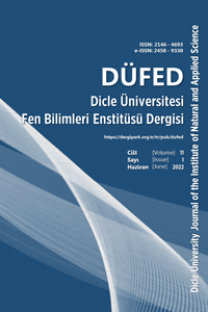Elektrik Motorlarının Arıza Tespitinin Otomatik Olarak Yapılmasında Kullanılan Yapay Öğrenme Yöntemleri
Elektrik motorlarının arıza tespiti ve arıza tespitinde kullanılan özelliklerin bir sınıflandırıcıda eğitilerek arıza tespitinin otomatik olarak yapılması üzerine yapılan çalışmalar gittikçe popüler hale gelmektedir. Bu çalışmada elektrik motorlarının arızalarının tespiti ve arıza şiddetinin belirlenmesinde etkin olan sinyal özellikleri kullanılarak motorun farklı yük ve hız durumlarında karakteristik özelliklerinin arıza şiddetine göre değişim miktarı sınıflandırıcı ağlarda eğitim ve test verileri olarak kullanılması, sınıflandırmanın başarısında etkili olmaktadır. Bu çalışmada arıza tespitinin otomatik olarak belirlenmesi amacıyla kullanılan çok katmanlı yapay sinir ağları MLP , destek vektör makinası SVM , k-en yakın komşuluk yöntemi kNN , karar ağacı DT ve Random Forest RF gibi örüntü tanıma ÖT yöntem ve algoritmaları anlatılmaktadır
Artificial Learning Methods for Automatic Fault Detection in Electric Motors
Studies on the automatic detection of faults and diagnostics of electrical motors by training them in a classifier are becoming increasingly popular. In this study, using the signal characteristics which are effective in determining the faults of the electric motors and determining the fault severity, the effect of changing the characteristics of the motor in different load and speed conditions according to the severity of the fault is used as training and test data in the classification networks. Pattern recognition methods such as multi-layer artificial neural networks MLP , support vector machine SVM , k-nearest neighbors method kNN , decision tree DT and random forest RF methods and algorithms are explained In this study as well
Keywords:
Otomatik motor arıza tespiti, Yapay öğrenme Sınıflandırma,
___
- C. Ortega, A. Arias, C. Caruana, J. Balcells, and G. M. Asher, “Improved waveform quality in the direct torque control of matrix-converter-fed PMSM drives,” IEEE Trans. Ind. Electron., vol. 57, no. 6, pp. 2101–2110, 2010.
- J. Beerten, J. Verveckken, and J. Driesen, “Predictive Direct Torque Control for Flux and Torque Ripple Reduction,” IEEE Trans. Ind. Electron., vol. 57, no. 1, pp. 404–412, 2010.
- R. Errouissi, M. . Ouhrouche, W.-H. . Chen, and A. M. Trzynadlowski, “Robust cascaded nonlinear predictive control of a permanent magnet synchronous motor with antiwindup compensator,” IEEE Trans. Ind. Electron., vol. 59, no. 8, pp. 3078–3088, 2012.
- K. Raggl, B. Warberger, T. Nussbaumer, S. Burger, and J. W. Kolar, “Robust angle-sensorless control of a PMSM bearingless pump,” IEEE Trans. Ind. Electron., vol. 56, no. 6, pp. 2076–2085, 2009.
- J. R. Riba Ruiz, J. A. Rosero, A. Garcia Espinosa, and L. Romeral, “Detection of demagnetization faults in permanent-Magnet synchronous motors under nonstationary conditions,” IEEE Trans. Magn., vol. 45, no. 7, pp. 2961–2969, 2009.
- A. von Jouanne and B. Banerjee, “Assessment of voltage unbalance,” IEEE Trans. Power Deliv., vol. 16, no. 4, pp. 782–790, 2001.
- S. Yu and R. Tang, “Electromagnetic and mechanical characterizations of noise and vibration in permanent magnet synchronous machines,” in IEEE Transactions on Magnetics, 2006, vol. 42, no. 4, pp. 1335–1338.
- S. Ruoho, J. Kolehmainen, J. Ikaheimo, and A. Arkkio, “Interdependence of Demagnetization, Loading, and 29. J. Rosero, L. Romeral, E. Rosero, and J. Urresty, “Fault Temperature Rise in a Permanent-Magnet Synchronous Motor,” IEEE Trans. Magn., vol. 46, no. 3, pp. 949–953, Mar. 2010.
- P. Zheng, J. Zhao, R. Liu, C. Tong, and Q. Wu, “Magnetic characteristics investigation of an axial-axial flux compound-structure PMSM used for HEVs,” in IEEE Transactions on Magnetics, 2010, vol. 46, no. 6, pp. 2191– 2194.
- Z. Guoxin, T. Lijian, S. Qiping, and T. Renyuan, “Demagnetization Analysis of Permanent Magnet Synchronous Machines under Short Circuit Fault,” Power Energy Eng. Conf. (APPEEC), 2010 Asia-Pacific, pp. 1–4, 2010.
- G. H. Kang, J. Hur, H. Nam, J. P. Hong, and G. T. Kim, “Analysis of irreversible magnet demagnetization in line- start motors based on the finite-element method,” IEEE Trans. Magn., vol. 39, no. 3 I, pp. 1488–1491, 2003.
- S. Nandi, H. A. Toliyat, and X. Li, “Condition Monitoring and Fault Diagnosis of Electrical Motors—A Review,” IEEE Trans. ENERGY Convers., vol. 20, no. 4, 2005.
- B. M. Ebrahimi and J. Faiz, “Diagnosis and performance analysis of three-phase permanent magnet synchronous motors with static, dynamic and mixed eccentricity,” IET Electr. Power Appl., vol. 4, no. 1, pp. 53–65, 2010.
- J. Hong, S. Bin Lee, C. Kral, and A. Haumer, “Detection of airgap eccentricity for permanent magnet synchronous motors based on the d-axis inductance,” IEEE Trans. Power Electron., vol. 27, no. 5, pp. 2605–2612, 2012. Detection in dynamic conditions by means of Discrete Wavelet Decomposition for PMSM running under Bearing Damage,” in 2009 Twenty-Fourth Annual IEEE Applied Power Electronics Conference and Exposition, 2009, pp. 951–956.
- J. R. Stack, T. G. Habetler, and R. G. Harley, “Fault classification and fault signature production for rolling element bearings in electric machines,” in IEEE International Symposium on Diagnostics for Electric Machines, Power Electronics and Drives, SDEMPED 2003 - Proceedings, 2003, pp. 172–176.
- J. R. Stack, R. G. Harley, and T. G. Habetler, “An amplitude Modulation detector for fault diagnosis in rolling element bearings,” IEEE Trans. Ind. Electron., vol. 51, no. 5, pp. 1097–1102, 2004.
- J. C. Urresty Betancourt, “Electrical and magnetic faults diagnosis in permanent magnet synchronous motors.” Universitat Politècnica de Catalunya.
- M. Arkan, H. Çaliş, and M. E. Tağluk, “Bearing and misalignment fault detection in induction motors by using the space vector angular fluctuation signal,” Electr. Eng., vol. 87, no. 4, pp. 197–206, 2005.
- ISSN: 2146-4693
- Yayın Aralığı: Yılda 2 Sayı
- Başlangıç: 2012
- Yayıncı: Dicle Üniversitesi
Sayıdaki Diğer Makaleler
KEÇİ YETİŞTİRİCİLİĞİNDE TEKE ETKİSİNDEN YARARLANMA
Durum Buğdayda Verim Öğelerinin Sıcaklık Stresine Tepkisi
Sertaç TEKDAL, Mehmet YILDIRIM, Hasan KILIÇ
Havası Alınmış Yalıtım Malzemelerinin Sıcak Su Dağıtım Borularında İncelenmesi
Hakan KESKİN, Murat DİNÇKURT, Aydoğan ÖZDAMAR
Sığırlarda besi sonu ağırlığına besi başı ağırlığının etkisinin kovaryans analizi ile incelenmesi
Dudu YAZGAN, Zeki DOĞAN, Kemal YAZGAN
Diyarbakır İli antepfıstığı Pistacia vera L. bahçelerindeki zararlı böcek faunasının belirlenmesi
DİYARBAKIR İLİNDE İPEKBÖCEĞİ YETİŞTİRİCİLİĞİNİN GENEL DURUMU
